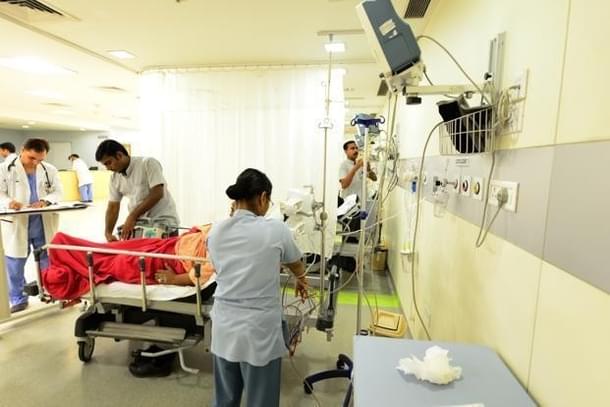Ideas
Is This ModiCare? What We Know About PM Modi’s Ambitious Ayushman Bharat Scheme
Swati Kamal
Aug 15, 2018, 04:22 PM | Updated 04:22 PM IST
Save & read from anywhere!
Bookmark stories for easy access on any device or the Swarajya app.


It was widely guessed that `Ayushman Bharat’ would find mention in Prime Minister Narendra Modi’s Independence Day Speech. And yes, today did become the inaugural day of the scheme, which is to benefit 50 crore Indians for serious medical conditions. Today, the scheme’s “technological testing” begins and will go on for the next five to six weeks, with the Pradhan Mantri Jan Aarogya Abhiyan to be launched on 25 September, birthday of Deen Dayal Upadhayay.
Technological Backing For Fool-proofing
Modi is right in allowing this length of time to test the software before the launch. The Centre’s role is to ensure a good support system: IT- and software-backing and tracking is indispensable for coordination, maintenance of all records, monitoring, processing claims, payments, and so on. Given the magnitude and coverage of the yojana as well as past experiences of different states with such schemes, using all tools and technology available to ensure that the deserving and the intended beneficiaries actually benefit becomes paramount. Additionally, a strong database through which genuine beneficiaries can be identified is a must, and Aadhaar cards are expected to serve this purpose across the country.
Also, technology to enable coordination at different levels, such as a Centre-level implementing and monitoring agency, and state-level bodies to collaborate with ministers, experts, social-sector specialists and others, is essential for smooth implementation of the scheme as well as keeping a check on malpractices by private hospitals and/or insurance companies. For this, according to news reports, an Ayushman Bharat National Health Protection Mission Council (AB-NHPMC) has been created at the Centre.
Thus, it’s been so far, so good.
Heartening News For The Middle Class
That this insurance scheme has great potential to bail out the poor from devastating circumstances was always known, and lauded: it would reduce out-of-pocket expenditure for 50 crore Indians, for whom expenditure related to illness is often catastrophic and drives them into vicious debt cycles. Also, it would give the poor across India access to good healthcare facilities for secondary and tertiary care.
A pleasant surprise and a big relief come for the middle class. Modi’s speech included the middle class as he spoke on the health insurance scheme. This is completely justified, given the rising costs of healthcare, and especially procedures related to serious illnesses. Given the increasing incidence of diseases requiring surgical intervention or even the costly medicines for illnesses like heart diseases, cancer, etc, it would have been unfair to leave the salaried and middle-income groups out just because they earned too much, to begin with, to qualify for financial assistance. Like the Prime Minister said, over a period of time, treatment does causes downward mobility, and has the potential to cause havoc in families, health-wise and otherwise. A support of this kind would go a long way in enabling the middle class to go about its business peacefully.
The States’ Position
Of course, implementation issues are bound to arise, and challenges would have to be met along the way, which will need redressal from time to time. The size of the country and its population is one issue. Complicating matters is our federal structure, with health being a state subject. There are problems of coordination with states running their own schemes.
According to this report in Moneycontrol, 28 states have signed MoUs with the government to participate in the scheme; states like Delhi, Telangana and Odisha are skipping it altogether. Among those on board, most have gone for the trust route, and a few with the insurance model.
Some states that had earlier refused to adopt the scheme on grounds that they have their own, have changed their mind – West Bengal for instance. We feel it is in the states’ own interest to go for the national scheme. Experience from forerunner states like Andhra Pradesh (with its Rajiv Arogyasri scheme) has that increase in health insurance premium leads to such cost escalations over time that even sustainability of the scheme becomes questionable; AP had to turn to the Centre for financial assistance, which was finally refused.
In the case of Modicare, the Centre already provides 60 per cent of the amount into the fund, freeing states’ funds to that extent. For the residual criteria that the national scheme does not cover – like differences in number of illness packages or category of beneficiaries – states can continue to carry on with smaller version of their schemes. Though the process will need thinking-through, it is not impossible.
The other big advantage from having one single scheme across the country is that it would allow for inter-regional treatment. Say, a person in Uttar Pradesh has a serious eye issue which would be best resolved in the LV Prasad Eye Institute in Hyderabad, the insurance under this national scheme will cover the travel costs also. The states’ own schemes lack this advantage.
Reaching Out Is All Important
Creating awareness is a big must for such a scheme to succeed, and for the good intentions of the policymakers to be realised. Information on what illnesses are covered and the options available for medical intervention must be available to patients. The Centre must rope in all possible agencies in this direction - communication and advertising agencies, organisations like UNICEF and rural NGOs. The latter could also help identify ground-level patient-counsellors who would also handhold the patient through the process(es). States like the erstwhile Andhra Pradesh had done a good job of this aspect, while Rajasthan’s Bhamashah healthcare scheme lost out on specifically this, despite having other great features. Finally, a strong grievance-redressal system must be in place, to register and rectify people’s issues.
Apparently, An Efficient Scheme
An important criticism that earlier state insurance schemes faced from experts was that instead of allocating so much money to insurance – which ultimately mostly went into the kitty of private hospitals – government should instead spend that money improving government hospitals. A second point often raised is that instead of insurance, the overall healthcare system must be strengthened, especially primary healthcare centres, so that disease conditions could be nipped in the bud early enough and not allowed to progress to serious illnesses that need secondary and tertiary care.
Fortunately, Ayushman Bharat, of which the health insurance scheme is the second part, has the solution to the above criticism in its first part: a Rs 1,200-crore programme for setting up 1.5 lakh health and wellness centres across the country; for this, CSR initiatives of corporates are also being considered. Also, Budget 2018 had announced the upgrade of 24 district hospitals to medical colleges and hospitals – one in each state, roughly.
In his speech today, Modi announced that healthcare systems in tier II and III towns would be improved. This also would serve to strengthen the public healthcare sector. In addition, existing public hospitals must be upgraded, ensuring infrastructure and specialist doctors in order that they can be equal players, alongside the private sector.
Coming to private healthcare players, they stand to gain from this huge insurance plan, but they must heed the lessons from the past: they have taken the flak not just in India, but across the world, for their pursuit of only-for-profit motive, fleecing government, and callous attitudes towards beneficiaries. This is their chance to act as if in a perfect-competition set-up: they must attract numbers of beneficiaries on the strength of their reputation – and thus, prove everyone wrong.
Ditto for insurance companies: research has demonstrated that instituting trust funds is more financially beneficial than hiring insurance agencies. It is for the insurance sector in India to demonstrate its indispensability this time around.
Indeed, for a truly Ayushman Bharat, all stakeholders will need to look within, spruce up their acts – and be in this together.
Swati Kamal is a columnist for Swarajya.





